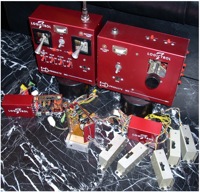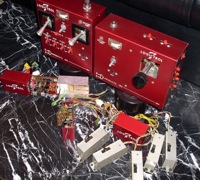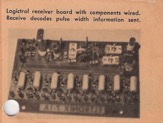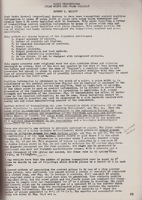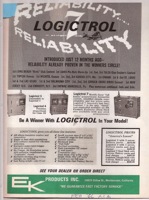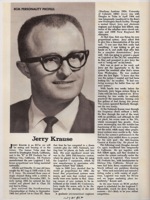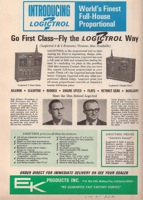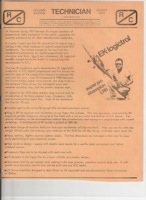Special Exhibit:
First Logictrol
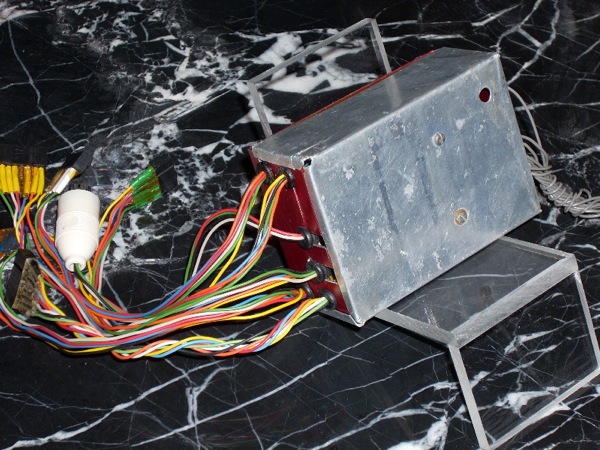
(Click on any of the images on this page to see a larger version)
This is the first Logictrol ever made. This prototype Logictrol receiver was flown by Jerry Krause at the 1964 Nationals in Dallas, Texas. Later that year he won first place with his prototype at the Mid-America Contest. That win gave Jerry and his partner, Bob Elliot, the boost they needed to launch their new company—EK Products (“E” for Elliot, “K” for Krause). EK grew to become a giant in RC manufacturing, able to claim it produced more digital proportionals than anyone else in the world.
It all started with this little beat-up receiver.
The First Logictrol.
When EK Products Inc. began producing Logictrol radio control systems they were 7 channels, not 5 like this prototype. The receivers of the initial production units were larger due to the extra channels and the need to leave additional space between components for production and servicing reasons. Here are two of Logictrol’s first production units for comparison, single and dual stick:
Origins
Krause and Elliot eventually settled on the name “Logictrol” for their new RC systems and never changed it. This name was inspired by their use of logic circuits to transmit and decode information by pulse width only. Here is Bob Elliot’s technical presentation on this (first page only) at the May 1964 DCRC Symposium:
Logictrol had the first variable frame rate system, enabling tighter servo resolution and finer control. But the difference between logic circuits and digital circuits/control was never completely clear. By 1966 they dropped the distinction and referred to Logictrol as digital. Here is an ad stressing how the Logictrol 7 was the only “digital” single stick system available (Feb 66 Radio Control Modeler magazine, or”RCM”).
Jerry Krause was a Graduate Aeronautical Engineer working for Douglas Aircraft Company when he met Bob Elliot in April, 1964. Elliot was an electronic engineer who was affiliated with Bonner Specialties and designed the relayless amplifier/circuit for the famous Bonner Transmite servos. These servos and their predecessor, the Bonner Duramites, were probably the most widely used multi actuators of their day. Shortly before leaving Bonner to develop a multi-proportional system, Elliot became familiar with Bonner’s full-house proportional the Digimite, designed by Gordon Larson and Frank Kagele, and still in development at that time. See “Prototype Bonner Digimite.” In his DCRC presentation (above), Elliot acknowledged the work of Larson and Kagele, and that of Doug Spreng and Don Mathes on the pioneering Digicon proportional.
Elliot was very bright, and it didn’t take him long to realize Krause was exactly the business partner he needed to help turn his designs into commercial success. Jerry Krause brought to their venture sterling engineering credentials, championship piloting skills, and keen business acumen—all housed in a personality which was among the most liked and trusted in the business. Here is a tribute to Krause by RCM which was published just after Logictrol’s first ads appeared:
It wasn’t long at all before these talented two enjoyed real success.
Low Prices—High Sales
Logictrol’s business strategy revolved around the theme of quality products at lower prices. They pioneered production in Mexico to take advantage of lower labor costs. This enabled them to offer modelers lower prices and was a major factor in their achievement of very large sales volumes. It also helped them to survive for years after other leading American manufacturers succumbed to growing foreign competition.
Some believe that Logictrol’s venture into lower priced systems came only after they initiated production in Mexico. But even their gleaming, U.S.-built initial systems were presented as a lower cost alternative. Here is the very first Logictrol advertisement (Jun 65 RCM). Note that it touts “America’s lowest prices” not once, but twice:
Here is Logictrol’s March, 1972 newsletter recounting its history and claiming it had become the largest proportional RC manufacturer:
Note that their claim is even bolder—that they produced more than all other manufacturers combined. We are unable to confirm this assertion at this time given the success of other industry leaders and the dominance of Kraft Systems, in particular. However, the fact that Logictrol was at least among the very top RC radio producers cannot be questioned and this success rested in large part on their lower price strategy. In addition, the true volume of Logictrol’s production was larger than may initially appear when one includes the many proportional radios they made for other applications (e.g. RC cars) and for other companies (e.g. Hobby Lobby). We understand a single contract for RC car radios required 20,000 systems!
Finally, Logictrol’s low prices did not mean low quality, and they were by no means limited to budget-priced , middle level systems. To learn more about Logictrol’s excellent top-of-the-line radios, see “Logictrol One”.



